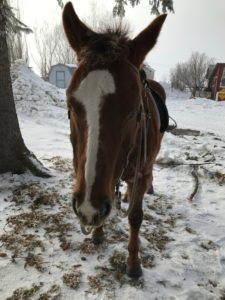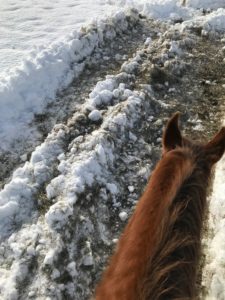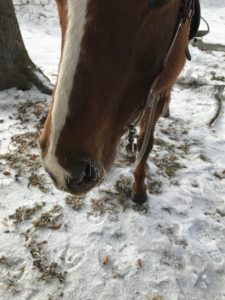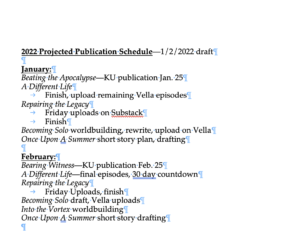Winter is definitely here, and one way it shows is what the old mare and I go through when riding. I keep her in work year-round, weather permitting, in part because she’s arthritic and in part because she enjoys doing something besides hanging out in the pasture. It’s easier to keep an older horse in light fitness during difficult weather if they’re sound than to let them decondition, then have to bring them back into fitness when conditions improve. Been there. Done that. Barring illness or injury, I’d sooner figure out ways to keep her safely in work.
She’s always been a horse who likes to be ridden, and now that semi-retirement is her gig, she enjoys small mental challenges, light schooling, and–her absolute favorite–road riding over familiar roads where she can snoop on what people/wildlife/livestock are doing. Oh yes, she is definitely a snoopy old lady, and she notices anything new on our rounds.
Some snow years, it never gets much deeper than 8 inches. That’s just about perfect for all three gaits–a bit of work, but cushioning from the hard frozen ground, and I dare say that the old lady somewhat enjoys galloping through snow.
This winter, however, has deep snow. As in 12-18 inches in places in the pasture. The horses–all of the herd–follow trails and tracks. Some are trails that they have made and firmed down through repeated use, especially from the bigger and taller horses. Mocha’s one of the shorties in the field at 14.2 hands high (one hand=4 inches, so she’s 58 inches high). Going through this deeper snow is work for the old lady, so….we follow trails and tracks.
Here’s some perspective on snow depth:
The barn owner uses the backhoe (which delivers the 1000 pound or so bales to the herd) to make safe trails for the horses around the scattered hay. They also plow out sections for the horses to walk. Since they feed in different locations in the 30-acre field, that means Mocha and I can manage to get light walk works in by following the backhoe tracks in areas away from the herd.
We don’t move out of a walk on these trails–the footing is too uncertain. Mocha prefers to move with her head lowered, whether she has a rider or not. But we manage to wind our way in and out through the trails and tracks, including sharp turns to change direction. Mocha likes that, and starts anticipating potential track variations.
Surprisingly, it’s pretty easy to rack up some distance on these circuits. We do five loops in one direction, five in the other.
Today, we went for 3.5 miles, according to my phone. All at a careful walk. It was sunny for most of the ride, but then the freezing fog rolled in, leaving its mark on Mocha’s whiskers, chest hair, and forelock. Not sure how well it will show up in the picture, but it’s worth a try.
Besides, you all like Mocha pix, right?












